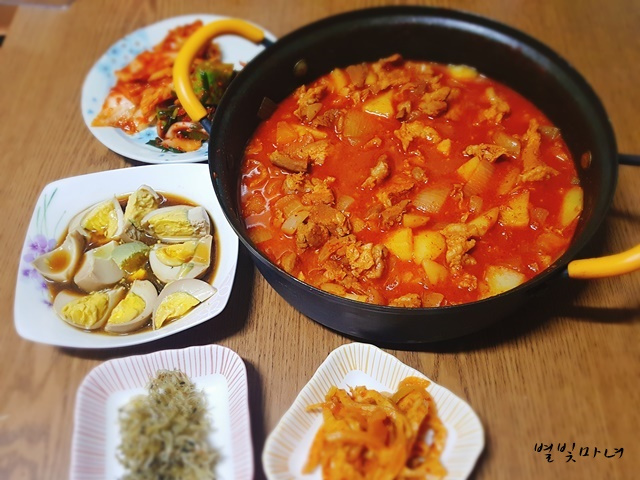Spicy and Rich! Super Simple Pork Gochujang Stew Recipe
The Essence of Home Cooking: Rice-Thief Pork and Potato Gochujang Stew

Introducing Gochujang Stew, a flavor that never gets old – a true Korean soul food! This stew harmonizes the savory depth of pork, the comforting texture of potatoes, and the natural sweetness of onions, creating a rich and profound taste that will have you devouring a bowl of rice in no time. Simply mix the prepared ingredients with the seasonings, stir-fry, add water, and simmer! You can easily create a delicious Gochujang stew without any complicated steps. If you enjoy a spicy kick, add 1-2 Cheongyang peppers for an even more robust flavor profile.
Main Ingredients- 4 Potatoes
- 1-2 Onions (medium-sized)
- 4 cloves Garlic or 1 Tbsp minced garlic
- 300g Pork (for stew)
Seasoning Ingredients- 2 Tbsp Anchovy Sauce (or fish sauce)
- 1 1/2 Tbsp Gochujang (Korean chili paste)
- 1 Tbsp Dadam Doenjang (Korean soybean paste)
- Pinch of Black Pepper (to taste)
- 1 Tbsp Soju (or rice wine)
- 500ml Water
- 2 tsp Gochugaru (Korean chili powder)
- Salt (for adjusting taste, to taste)
- 2 Tbsp Anchovy Sauce (or fish sauce)
- 1 1/2 Tbsp Gochujang (Korean chili paste)
- 1 Tbsp Dadam Doenjang (Korean soybean paste)
- Pinch of Black Pepper (to taste)
- 1 Tbsp Soju (or rice wine)
- 500ml Water
- 2 tsp Gochugaru (Korean chili powder)
- Salt (for adjusting taste, to taste)
Cooking Instructions
Step 1
First, prepare the core ingredients for the stew: potatoes, onions, and garlic. Wash and peel 4 potatoes. Prepare 1 medium-sized onion and 1 small onion. You can use 4 cloves of garlic or 1 tablespoon of minced garlic. Personally, I find that mincing fresh garlic each time results in a better aroma.

Step 2
Cut the potatoes into bite-sized pieces. A common way is to halve them and then cut each half into 4 pieces, or cut them into roughly triangular shapes. If you avoid stirring too vigorously while simmering, the potatoes will hold their shape better.

Step 3
Slice the onions to a similar size as the potatoes. Cutting the ingredients to a similar size ensures they cook evenly and makes the stew visually appealing.

Step 4
If you have minced garlic, it’s convenient to use it directly. I minced fresh garlic myself, and I recommend it for its vibrant flavor.

Step 5
Prepare 300g of pork. If you dislike excess fat, you can trim it off with a knife. However, a moderate amount of fat in the pork contributes to a richer, less ‘muddy’ flavor from the gochujang. The cut I used had a good balance of fat, so I used it as is. Pork with very little fat can sometimes make the gochujang taste dull.

Step 6
Add 2 tablespoons of anchovy sauce to the prepared pork to enhance its depth of flavor. If you don’t have anchovy sauce, you can substitute it with fish sauce or Korean soup soy sauce.

Step 7
Add 1 1/2 tablespoons of gochujang, the star ingredient of this stew, generously. Be mindful of the amount to avoid making it too salty.

Step 8
Sprinkle a pinch of black pepper to taste for added aroma.

Step 9
Add 1 tablespoon of Dadam Doenjang (Korean soybean paste) to balance the spicy gochujang with its savory notes. Doenjang helps to harmonize the overall flavor.

Step 10
Add 1 tablespoon of soju to eliminate any porky odors and help the seasonings penetrate the meat. Mix everything thoroughly with your hands until the seasoning is evenly distributed. Let it marinate for about 5 minutes; this step significantly deepens the flavors.

Step 11
In a pot, combine the marinated pork with the prepared potatoes and onions. Stir-fry over medium heat for about 5 minutes. This pre-frying step further enhances the flavors of the meat and vegetables, leading to a richer stew.

Step 12
Once the ingredients are slightly stir-fried, pour in 500ml of water. You can adjust the amount of broth according to your preference.

Step 13
As the water comes to a boil, add 2 teaspoons of gochugaru (Korean chili powder) for a spicier kick and a more appealing color. Then, bring it to a boil, reduce the heat to medium-low, and let it simmer until the liquid has reduced by about one-third. Stir only once or twice during this period, and mostly let it simmer undisturbed. This process allows the flavors to concentrate beautifully into the broth.

Step 14
Can you see the difference between when you first added the water and after simmering? Following this recipe, you won’t need to adjust the seasoning further; the natural sweetness of the gochujang and the ingredients create a perfectly delicious stew. It’s so satisfying served over a bowl of hot rice! If you like it spicier, feel free to add Cheongyang peppers for an extra kick.




